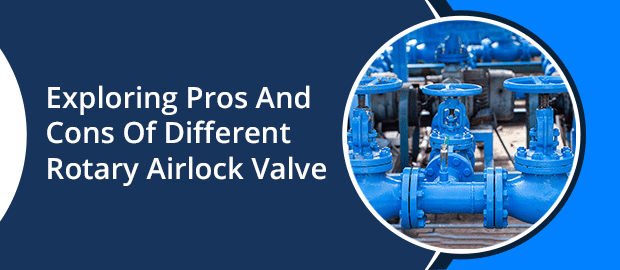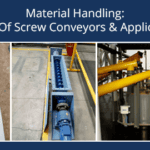The rotary airlock valve is a specific type of industrial component with an inlet & outlet mechanism. It is used in most applications where any material needs to be controlled with varying pressures.
Moreover, the rotary airlock valve is also used to control the fluids when handled at various temperatures. It can withstand immense pressure, making it an optimal choice for gas and liquid transportation, even in harsh environments.
There are ample applications for which the rotary airlock valve has proven itself highly impactful. So, in this article, you will learn the pros and cons of different rotary airlock valve components and their various applications.
Make Your Best Decision with Our Rotary Airlock Valve Analysis! Choose One That Fits Your Needs.
Pros And Cons Of Different Rotary Airlock Valves
Make sure you know the advantages and disadvantages of rotary valves and which one is ideal for your application. You must get an insight into the same for all available options. Therefore, here are particular disadvantages and advantages of a rotary valve, associated with various types and applications, for you to consider:
1. BAV (Blow-Thru Abrasion-Resistant Valve) Rotary Airlock Valve
The BAV rotary airlock valve comes with ports on both sides of its end covers. The ports will connect directly to convey to the line pipe. Following that, the convey line air then blows through the integrated rotor pockets, making the process very efficient while cleaning out the pockets.
Advantages:
- Heavy dust casting.
- Tightened tolerance level due to large shafts & thick vanes.
- Available with unlimited rotor options.
- Improved concentricity.
- It comes with minimal clearances between the housing and rotor.
Disadvantages:
- Comes with limited sealing propositions.
- Cleaning such airlock valves is very complex.
Applications:
- Used for the feeder applications.
- Used for filter applications for the maintenance of an air seal.
- Used for pneumatic conveying applications.
2. CI (Cast Iron) Rotary Airlock Valve
The cast iron rotary airlock valves are meant to add strength and capacity to serve the end purpose. It is mostly used for applications that involve the handling of bulk materials. It is also popularly known as the housing-style rotary airlock valve, which reduces the overall cost, and imparts the rigidity quotient.
Advantages:
- Ability to handle pellets, granules, and other such materials in bulk.
- Highly resistant to increased temperatures at operating sites.
- Ensures no material degradation upon use.
Disadvantages:
- No resistance against corrosion.
- Being dense, cast iron is a heavy material, making the valve difficult to install.
Applications:
- Material conveying systems.
- Air pollution systems.
- Pneumatic conveying systems.
- Dust suppression equipment.
- Cement & abrasive material manufacturing factories.
3. SS (Stainless Steel) Rotary Airlock Valve
The stainless steel rotary airlock valves are used for discharging the dust particles from the bag filter or cyclomax hopper. These lock valves can maintain the pressure at which the system operates. You can avail of this valve in various sizes or capacities per industry requirements.
Advantages:
- Handles materials such as sugar, cement, flour, plastic and chips.
- Capable of withstanding operating temperatures of up to 500-degree-Fahrenheit.
- Possible to integrate with guard and drive systems for the airlocks.
- Resistance from corrosion, ensuring longevity and enhanced performance.
Disadvantages:
- The initial cost is high for the SS rotary airlock valve.
- Cannot be used in isolated electricity or controlled temperature applications.
Applications:
- Dust collection system.
- Pneumatic conveying.
- Cyclonic discharge.
- Unloading material from dust or discharger collector.
4. SQ (Square) Rotary Airlock Valve
It is a unique type of rotary airlock valve manufactured with square-shaped flanges at both inlet and outlet. Such a shape supports flanges to attain a seamless connection to the square/rectangular equipment. Following that, it also has a round-shaped rotor chamber, which smoothes the flow of material without any blockages.
Advantages:
- Supports controlled transferring of various materials.
- Embedded with sealing mechanisms.
- Prevents bridging or backflow of the materials.
- Ideal for use in the food processing and agriculture industry.
Disadvantages:
- Limited application for certain materials that are cohesive, sticky, or have poor flow properties.
- Increased risk of leakage.
Applications:
- External application at the silos and hoppers.
- Mixing & bending equipment.
- Batch processing equipment or systems.
- Feeding systems of pelletizers for extruders.
Make Your Best Decision with Our Rotary Airlock Valve Analysis! Choose One That Fits Your Needs.
5. Heavy Duty Rotary Airlock Valve
The heavy-duty rotary airlock valve is quite rugged and durable, which supports the seamless flow of free-flowing or dry powders from the bins to pneumatic systems. The design aims to maintain the differential pressure of up to +/- 15 PSI. It is made up of either cast iron or stainless steel.
Heavy duty cast iron rotary airlock valve is meant for serving numerous industrial applications, resistant to corrosion and wear & tear. It has excellent sealing integrity, for preventing the leakage of gas or air, between the important pressure zones.
Advantages:
- Highly durable and long-lasting without much maintenance hassle.
- The temperature and pressure ratings are optimal for intensive applications.
- Resistant to damages caused by abrasive materials.
- Available in various sizes and configurations to support diverse applications.
Disadvantages:
- The high initial cost of investment.
- Enhanced power consumption.
Applications:
- Well-suited for dealing with abrasive materials.
- Feeding applications.
- Dust collection operations.
- Pneumatic conveying operations.
6. OGV (Open Gear Drive) Rotary Airlock Valve
The OGV (Open Gear Drive) Rotary Airlock Valve is designed with an open-gear drive system that enables the rotation of a rotor housed within the valve. As the rotor spins, it creates a secure seal between different pressure zones, preventing leakage and maintaining the system’s integrity.
The OGV (Open Gear Drive) Rotary Airlock Valve is used to transfer powdered or granular substances in industries such as food processing, chemical manufacturing, and material handling.
Advantages:
- Built to withstand harsh operating conditions.
- Ensures consistent and controlled material flow.
- Prevents contamination and maintains system efficiency.
- Simple design allows for convenient cleaning and servicing.
Disadvantages:
- Compared to other types of valves, OGV valves may have a higher upfront investment.
- Not suitable for extreme temperature and pressure conditions.
Applications:
- Pneumatic conveying applications.
- Material handling systems.
- Dust collection operations.
7. SAGV (Side-Entry Abrasion-Resistant Gear Drive) Rotary Airlock Valve
The SAGV or side-entry rotary airlock valve is meant for applications where the risk of product shearing is high. The name side-entry explains how the inlet & outlet flanges are positioned on the side of the rotor. It is available with rectangular and round frames for dedicated applications.
Advantages:
- The valve is built with abrasion-resistant components, ensuring extended service life even in harsh operating conditions.
- It provides reliable and consistent material flow control, optimising the overall productivity of the industrial process.
- The valve’s robust construction reduces the frequency of maintenance and replacement, resulting in cost savings.
Disadvantages:
- High initial investment.
- Being heavy demands additional support equipment.
Applications:
- Used in cement industry applications.
- Mining and mineral processing.
- Power generation.
8. CI-HD (Heavy-Duty Cast Iron) Rotary Airlock Valve
The CI-HD (Heavy-Duty Cast Iron) Rotary Airlock Valve is constructed using heavy-duty cast iron components, which provide exceptional durability and strength, making it suitable for demanding environments. The robust construction of the valve enables it to handle abrasive materials and withstand harsh operating conditions.
It acts as a vital component in material handling systems, ensuring controlled and efficient transfer of bulk materials, such as powders, granules, and pellets, in industries such as agriculture, food processing, mining, plastics, and recycling. The CI-HD Rotary Airlock Valve guarantees long-lasting performance and reliable operation in challenging industrial settings.
- Suitable for handling abrasive materials and withstanding harsh operating conditions.
- Compared to other high-end materials, cast iron valves offer a more affordable option without compromising on performance and reliability.
- The valve can be integrated into various systems and processes, offering flexibility in industrial applications.
Disadvantages:
- Cast iron valves are prone to corrosion, especially in corrosive surroundings, necessitating maintenance and protection.
- The valve’s heavy construction increases weight, affecting installation, transportation, and necessitating additional support.
Applications:
- Material handling applications
- Woodworking applications.
- Recycling facilities applications.
Make Your Best Decision with Our Rotary Airlock Valve Analysis! Choose One That Fits Your Needs.
Conclusion
With this article, you are now clear on the benefits of using rotary valves of various types, being used in diverse applications. You must know that, with advantages, there are still some limitations of rotary valves, which will contribute towards helping you decide on whether or not the rotor airlock valve is meant for serving your applications.
These valves are categorised into different sizes and types to fit various industries and their core applications.
Whether mining, hygiene, cement, food processing or any other industry, the demand for airlock valves has been increasing stupendously. If you are looking for a Pneumatic conveying system manufacturer in India, then look no more as MacAwber India is here to meet those needs.



